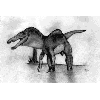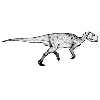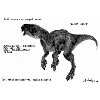“parrot lizard”
CLASSIFICATION
| Psittacosaurus Osborn, 1923TYPE SPECIES: P. mongoliensis Osborn, 1923 “parrot lizard from Mongolia” OTHER SPECIES: P. mazongshanensis Xu, 1997 P. meileyingensis Sereno, Zhao, Zheng & Rao, 1988 P. neimongoliensis D. A. Russell & Zhao, 1996 P. ordosensis D. A. Russell & Zhao, 1996 P. sattayaraki Buffetaut & Suteethorn, 1992 P. sinensis Young, 1958 “parrot lizard from China” P. sp. P. xinjiangensis Sereno & Zhao, 1988 MISASSIGNED SPECIES: P. chaoyangi Wang, 1983 [nomen nudum] “parrot lizard from Chaoyang County” == Chaoyangsaurus youngi P. guyangensis Zheng, 1983 == P. mongoliensis P. osborni Young, 1931 “Henry F. Osborn’s parrot lizard” == P. mongoliensis P. protiguandonensis Young, 1958 “parrot lizard from before Iguanodon“ == P. mongoliensis P. tingi Young, 1931 == P. osborni P. youngi Zhao, 1962 == P. sinensis | Animalia Vertebrata Tetrapoda Sauropsida Archosauromorpha Ornithodira Dinosauria Ornithischia Ceratopsia |
see also: Genus Index, Classification
MEASUREMENTS
| LENGTH: 80 cm to 2 m | MASS: 25 kg |
TIME
Aptian to Albian
P. sp.: Early Cretaceous
P. mongoliensis: Aptian
P. meileyingensis: late Aptian
see also: Ages of the Mesozoic
PLACE
P. mongoliensis: China, Mongolia
P. mazongshanensis: China
P. meileyingensis: China
P. sattayaraki: Thailand
P. sinensis: China
P. sp.: Mongolia
P. xinjiangensis: China
REMAINS
- P.mongoliensis
- remains from over 85 individuals
- P.mazongshanensis
- skull, vertebrae, forelimb, gastrolith impressions
- P.meileyingensis
- 4 specimens (2 with complete skulls)
- P.neimongoliensis
- nearly complete skeleton
- P.ordosensis
- nearly complete skeleton
- P.sattayaraki
- dentary, maxilla fragment
- P.sinensis
- material from over 20 individuals
- P. sp.
- partial skull, articulated skeleton with gastroliths
- P.xinjiangensis
- material from over 10 individuals
ESSAY
| Psittacosaurus was originally classified in Ornithopoda, mainly due to its bipedal stance. One specimen was actually named Protiguanodon (“before Iguanodon“, Iguanodon being a typical ornithopod). But Psittacosaurus was soon recognized as being closer to ceratopsids than ornithopods. In fact, it represents a transitional phase from early, ornithopod-like ornithischians to the large, mostly quadrupedal neoceratopsians.This genus has more valid species than any other non-neornithean dinosaur. Some think it should be split into more genera, although there have been no formal proposals. |
IMAGES
Click on thumbnail to see full image.

A great Suchomimus tenerensis rests peacefully in the middle of a little river. |


